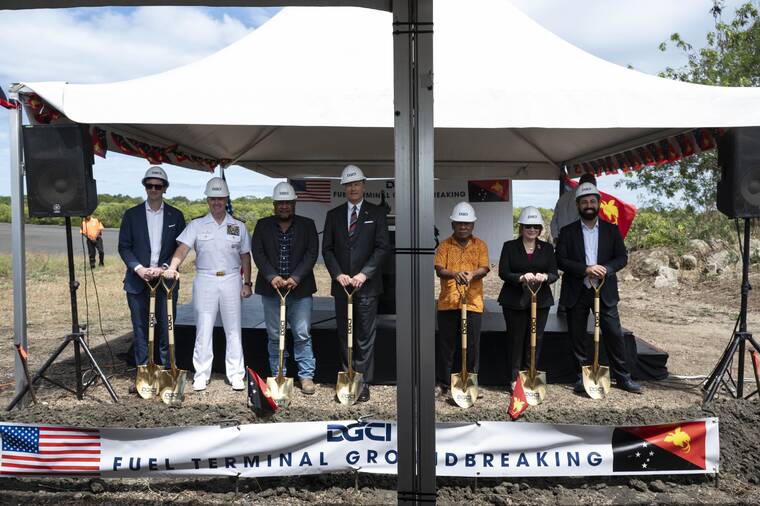
The U.S. military is advancing its refueling strategy in the Pacific by constructing a new facility in Papua New Guinea (PNG). This move follows the decision to shut down the controversial Red Hill fuel storage facility located on Oahu, Hawaii. During a recent visit, Adm. Samuel Paparo, commander of the U.S. Indo-Pacific Command, attended a groundbreaking ceremony for the new fuel complex in Port Moresby on September 15, 2023. He was accompanied by Christopher Landau, the U.S. Deputy Secretary of State, as PNG celebrated its 50th anniversary of independence from Australia.
The new facility, which is expected to hold approximately 70 million gallons of fuel, is part of a broader strategy to reposition U.S. military resources in the region. The contract for construction has been awarded to DGCI Corp., an aerospace and defense company based in McLean, Virginia, with the project slated for completion by 2030 at an estimated cost of $400 million.
As the military transitions away from the Red Hill facility, which had a storage capacity of up to 250 million gallons, it is implementing a “distributed” fueling strategy. This approach involves spreading fuel reserves across various facilities and tanker ships throughout the region to enhance operational flexibility and resilience.
The strategic importance of Papua New Guinea has heightened as competition for influence between the United States and China intensifies in the Pacific Islands. PNG, the most populous nation in the Pacific, boasts a diverse population that speaks over 800 indigenous languages and is rich in natural resources, including gold, nickel, and natural gas. Previous high-profile visits, such as that of Chinese President Xi Jinping in 2018, underscore the nation’s geopolitical significance.
Paparo’s visit included discussions with PNG’s Prime Minister, James Marape, along with officials from Australia, Fiji, Tonga, and New Zealand. This engagement aligns with a regional tour aimed at strengthening alliances in light of ongoing tensions with China.
The operational shift comes after the Pentagon faced significant challenges related to the Red Hill facility. Following a leak in 2021 that contaminated the water supply for over 93,000 people, including military personnel and civilians, the U.S. military was compelled to defuel the site, which is situated just 100 feet above a critical aquifer for Oahu. The contamination resulted in serious health issues for many residents, prompting widespread concern.
Initially resistant to an emergency order to defuel, the Pentagon eventually established a task force in 2022 that removed much of the fuel by March 2024. Despite previous assurances of safety, the Navy acknowledged that the aging complex required extensive repairs and upgrades to ensure safe fuel removal.
The broader implications of relocating strategic fuel reserves are under scrutiny. A senior defense official indicated that while the current strategy may suffice temporarily, more long-term solutions will be necessary to offset the loss of Red Hill. The military has begun relocating usable fuel to various storage points, including facilities in San Diego, California, and Subic Bay, Philippines.
The establishment of the new facility in PNG is part of a wider defense agreement between the U.S. and PNG aimed at increasing military cooperation. In April 2023, the U.S. Naval Facilities Engineering Systems Command began construction on two additional facilities at Lombrum Naval Base on Manus Island. This location previously hosted a significant number of U.S. military personnel during World War II.
While the increased military engagement has its advocates, it has sparked criticism as well. Former Prime Minister Peter O’Neill expressed concerns that the current government, led by Marape, has positioned PNG at the center of a geopolitical conflict without adequate public consultation.
Simultaneously, the U.S. military’s refueling operations in the Pacific face ongoing scrutiny. A shipment of fuel sent to Subic Bay generated controversy, prompting accusations from Philippine officials regarding transparency. Additionally, a recent investigation by the Pentagon Inspector General found systemic issues with oversight and record-keeping at military fuel facilities worldwide, raising alarms about environmental risks.
In July 2023, the Honolulu Board of Water Supply filed a federal civil tort complaint against the Navy, seeking accountability for the handling of fuel leaks at Red Hill, estimating the costs associated with these leaks at around $1.2 billion.
As the U.S. military continues to adapt its refueling strategies, the implications for regional stability and environmental safety remain significant considerations moving forward.







